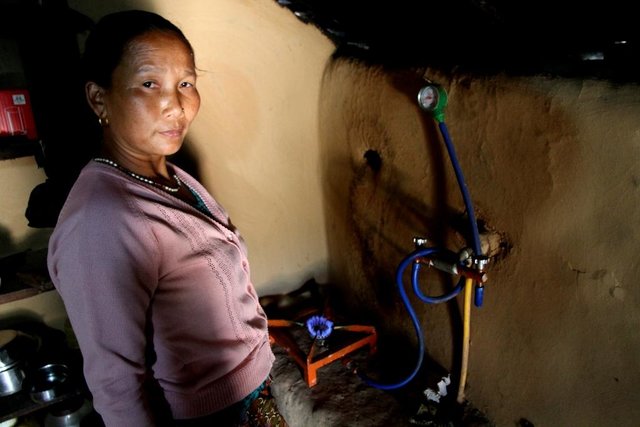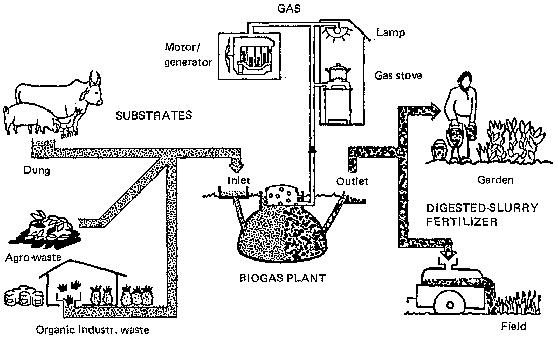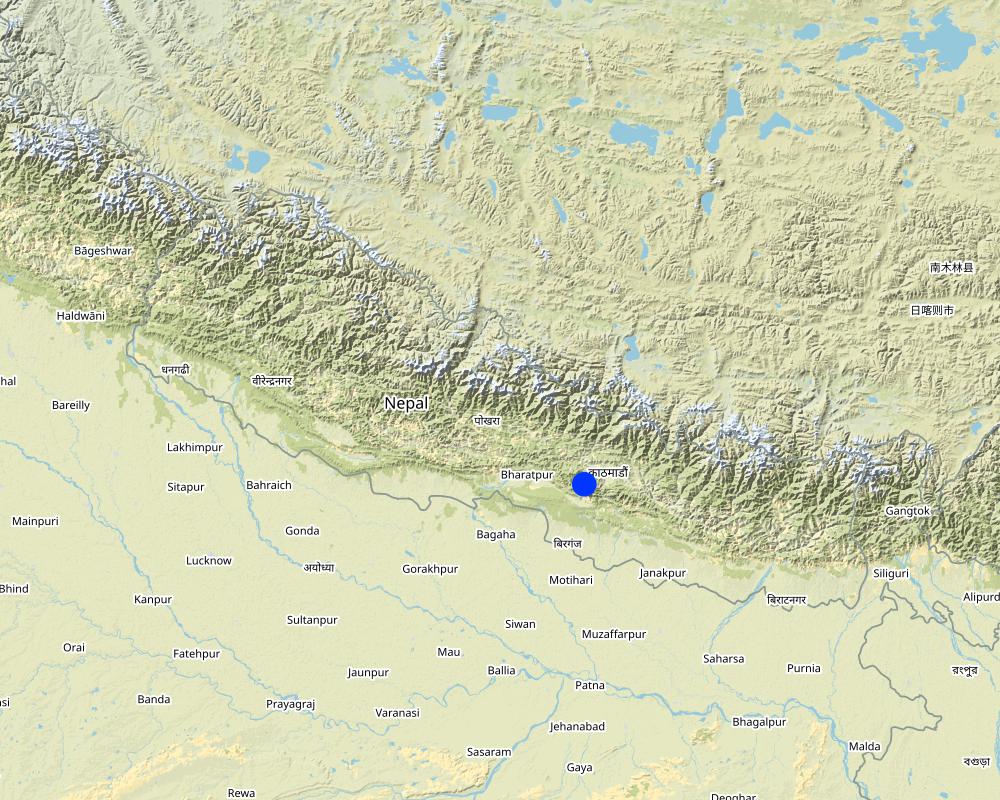Bio Gas [Nepal]
- Creation:
- Update:
- Compiler: Sabita Aryal
- Editor: –
- Reviewers: Alexandra Gavilano, David Streiff, Joana Eichenberger
Gobar gas (nepali)
technologies_1235 - Nepal
View sections
Expand all Collapse all1. General information
1.2 Contact details of resource persons and institutions involved in the assessment and documentation of the Technology
Key resource person(s)
SLM specialist:
SLM specialist:
Pantha Samikshya
Kathmandu University
Nepal
SLM specialist:
Giri Gyanu
Kathmandu University
Nepal
SLM specialist:
Piya Shristi
Kathmandu University
Nepal
SLM specialist:
Baidya Khatri Raghuram Ratna
Sarada Batase VDC
Nepal
1.3 Conditions regarding the use of data documented through WOCAT
The compiler and key resource person(s) accept the conditions regarding the use of data documented through WOCAT:
Yes
1.4 Declaration on sustainability of the described Technology
Is the Technology described here problematic with regard to land degradation, so that it cannot be declared a sustainable land management technology?
No
1.5 Reference to Questionnaire(s) on SLM Approaches (documented using WOCAT)

Bio-gas [Nepal]
Production of fuel from the animal waste.
- Compiler: Sabita Aryal
2. Description of the SLM Technology
2.1 Short description of the Technology
Definition of the Technology:
Production of fuel and manure from animal waste
2.2 Detailed description of the Technology
Description:
People here use animal as well as human waste for the production of biogas.Equal amount of dung and water is poured in the inlet and mixed by the help of mixture.Then the raw materials are passed to the digestor where gas (methane) is produced by an anerobic fermentation by methanogenic bacteria. The produced gas is collected in dome and slurry is drained out through an outlet.
Purpose of the Technology: The biogas produced from the plant is used as a fuel for cooking food. The bio gas produced can also be used to light bulbs.The slurry can be used as manure in agricultural fields.
Establishment / maintenance activities and inputs: About 24% houses is using this technique by the funds from international , national (government) and few by self funding . The digester should be cleaned every five years of its use.
Natural / human environment: Temperature maintenance is basic requirement for biogas production. (36 degree celsius).
It is most favorable if the plant is near the water resources and near to the fuel source i.e. cattle house.
2.3 Photos of the Technology
2.5 Country/ region/ locations where the Technology has been applied and which are covered by this assessment
Country:
Nepal
Region/ State/ Province:
Nepal
Further specification of location:
Kavre
Specify the spread of the Technology:
- evenly spread over an area
If precise area is not known, indicate approximate area covered:
- > 10,000 km2
Comments:
Boundary points of the Technology area: Altitude about 4900 feets
Map
×2.6 Date of implementation
If precise year is not known, indicate approximate date:
- 10-50 years ago
2.7 Introduction of the Technology
Specify how the Technology was introduced:
- during experiments/ research
3. Classification of the SLM Technology
3.1 Main purpose(s) of the Technology
- improve production
3.2 Current land use type(s) where the Technology is applied

Cropland
- Annual cropping
- Tree and shrub cropping
Annual cropping - Specify crops:
- root/tuber crops - potatoes
Tree and shrub cropping - Specify crops:
- citrus
Comments:
Major cash crop: Potatoes and oranges
Major land use problems (compiler’s opinion): Loss of fertile soil
Future (final) land use (after implementation of SLM Technology): Cropland: Ca: Annual cropping
3.4 Water supply
Water supply for the land on which the Technology is applied:
- mixed rainfed-irrigated
3.5 SLM group to which the Technology belongs
- energy efficiency technologies
3.6 SLM measures comprising the Technology

agronomic measures
- A7: Others
Comments:
Type of agronomic measures: better crop cover, manure / compost / residues
3.7 Main types of land degradation addressed by the Technology

chemical soil deterioration
- Cn: fertility decline and reduced organic matter content (not caused by erosion)
Comments:
Main causes of degradation: deforestation / removal of natural vegetation (incl. forest fires), inputs and infrastructure: (roads, markets, distribution of water points, other, …)
Secondary causes of degradation: crop management (annual, perennial, tree/shrub), over-exploitation of vegetation for domestic use, overgrazing, change in temperature, change of seasonal rainfall, Heavy / extreme rainfall (intensity/amounts), wind storms / dust storms, floods, droughts, population pressure, land tenure, poverty / wealth, labour availability, governance / institutional
3.8 Prevention, reduction, or restoration of land degradation
Specify the goal of the Technology with regard to land degradation:
- reduce land degradation
4. Technical specifications, implementation activities, inputs, and costs
4.1 Technical drawing of the Technology
Technical specifications (related to technical drawing):
First a pit is dug, perhaps ten feet deep. Then a water tight cement cylinder is constructed. Intake and outgo pipes are installed. The whole unit is made water tight. The manure is mixed with water in the intake basin to make slurry which then goes down the pipe to the digester. This whole cylinder is filled. Meanwhile, the whole mass bubbles methane up to the top. The gas builds the pressure and can be taken off through a rubber tube to a gas stove in the kitchen. When the cylinder is full the effluent comes out through the outer inlet, which is the byproduct of the plant and is the fertilizer for the field.
Location: Sarada Batase , VDC
Technical knowledge required for field staff / advisors: moderate
Technical knowledge required for land users: moderate
Main technical functions: stabilisation of soil (eg by tree roots against land slides)
Secondary technical functions: increase in organic matter, increase in nutrient availability (supply, recycling,…), spatial arrangement and diversification of land use
4.4 Costs and inputs needed for establishment
| Specify input | Unit | Quantity | Costs per Unit | Total costs per input | % of costs borne by land users | |
|---|---|---|---|---|---|---|
| Labour | Labour | unit | 1.0 | 4500.0 | 4500.0 | |
| Equipment | Animal traction | unit | 1.0 | 5765.0 | 5765.0 | |
| Total costs for establishment of the Technology | 10265.0 | |||||
| Total costs for establishment of the Technology in USD | 10265.0 | |||||
4.5 Maintenance/ recurrent activities
| Activity | Timing/ frequency | |
|---|---|---|
| 1. | Digestor cleaning | 5 years |
| 2. | Refilling the digestor | Daily |
4.7 Most important factors affecting the costs
Describe the most determinate factors affecting the costs:
1) Size of biogas plant
2) Materials required to build the plant
3) Labour Cost
5. Natural and human environment
5.1 Climate
Agro-climatic zone
- sub-humid
- semi-arid
Thermal climate class: tropics
5.2 Topography
Slopes on average:
- flat (0-2%)
- gentle (3-5%)
- moderate (6-10%)
- rolling (11-15%)
- hilly (16-30%)
- steep (31-60%)
- very steep (>60%)
Landforms:
- plateau/plains
- ridges
- mountain slopes
- hill slopes
- footslopes
- valley floors
Altitudinal zone:
- 0-100 m a.s.l.
- 101-500 m a.s.l.
- 501-1,000 m a.s.l.
- 1,001-1,500 m a.s.l.
- 1,501-2,000 m a.s.l.
- 2,001-2,500 m a.s.l.
- 2,501-3,000 m a.s.l.
- 3,001-4,000 m a.s.l.
- > 4,000 m a.s.l.
Comments and further specifications on topography:
Landforms: Also valley floors
5.3 Soils
Soil depth on average:
- very shallow (0-20 cm)
- shallow (21-50 cm)
- moderately deep (51-80 cm)
- deep (81-120 cm)
- very deep (> 120 cm)
Soil texture (topsoil):
- medium (loamy, silty)
If available, attach full soil description or specify the available information, e.g. soil type, soil PH/ acidity, Cation Exchange Capacity, nitrogen, salinity etc.
Soil fertility is high - medium
Soil water storage capacity is high
5.4 Water availability and quality
Ground water table:
5-50 m
Availability of surface water:
good
5.5 Biodiversity
Species diversity:
- medium
5.6 Characteristics of land users applying the Technology
Market orientation of production system:
- subsistence (self-supply)
- commercial/ market
Off-farm income:
- 10-50% of all income
Relative level of wealth:
- poor
Individuals or groups:
- individual/ household
Level of mechanization:
- manual work
- mechanized/ motorized
Indicate other relevant characteristics of the land users:
Population density: 100-200 persons/km2
Annual population growth: 1% - 2%
5.7 Average area of land used by land users applying the Technology
- < 0.5 ha
- 0.5-1 ha
- 1-2 ha
- 2-5 ha
- 5-15 ha
- 15-50 ha
- 50-100 ha
- 100-500 ha
- 500-1,000 ha
- 1,000-10,000 ha
- > 10,000 ha
Is this considered small-, medium- or large-scale (referring to local context)?
- small-scale
5.8 Land ownership, land use rights, and water use rights
Land ownership:
- communal/ village
Land use rights:
- individual
5.9 Access to services and infrastructure
health:
- poor
- moderate
- good
education:
- poor
- moderate
- good
technical assistance:
- poor
- moderate
- good
employment (e.g. off-farm):
- poor
- moderate
- good
markets:
- poor
- moderate
- good
energy:
- poor
- moderate
- good
roads and transport:
- poor
- moderate
- good
drinking water and sanitation:
- poor
- moderate
- good
financial services:
- poor
- moderate
- good
6. Impacts and concluding statements
6.1 On-site impacts the Technology has shown
Socio-economic impacts
Production
crop production
wood production
production area
energy generation
Income and costs
expenses on agricultural inputs
farm income
workload
Comments/ specify:
No need to collect wood
Socio-cultural impacts
food security/ self-sufficiency
health situation
livelihood and human well-being
Comments/ specify:
With the help of this technology the living standard of rural women and men has been improved. It has increased the employment as well as productivity. It has also reduce dependency on traditional energy and attain sustainable development via integrating the alternative energy with the socio-economic activities of women and men in rural communities.
Ecological impacts
Water cycle/ runoff
surface runoff
Soil
soil moisture
nutrient cycling/ recharge
soil organic matter/ below ground C
Biodiversity: vegetation, animals
biomass/ above ground C
pest/ disease control
Climate and disaster risk reduction
emission of carbon and greenhouse gases
6.2 Off-site impacts the Technology has shown
groundwater/ river pollution
damage on neighbours' fields
6.3 Exposure and sensitivity of the Technology to gradual climate change and climate-related extremes/ disasters (as perceived by land users)
Gradual climate change
Gradual climate change
| Season | increase or decrease | How does the Technology cope with it? | |
|---|---|---|---|
| annual temperature | increase | not well |
Climate-related extremes (disasters)
Meteorological disasters
| How does the Technology cope with it? | |
|---|---|
| local rainstorm | not well |
| local windstorm | well |
Climatological disasters
| How does the Technology cope with it? | |
|---|---|
| drought | not well |
Hydrological disasters
| How does the Technology cope with it? | |
|---|---|
| general (river) flood | not well |
6.4 Cost-benefit analysis
How do the benefits compare with the establishment costs (from land users’ perspective)?
Short-term returns:
slightly positive
Long-term returns:
positive
How do the benefits compare with the maintenance/ recurrent costs (from land users' perspective)?
Short-term returns:
positive
Long-term returns:
neutral/ balanced
6.5 Adoption of the Technology
Comments:
There is a little trend towards spontaneous adoption of the Technology
6.7 Strengths/ advantages/ opportunities of the Technology
| Strengths/ advantages/ opportunities in the land user’s view |
|---|
| used as a fertilizer |
| Efficient cooking method. |
| Strengths/ advantages/ opportunities in the compiler’s or other key resource person’s view |
|---|
| Decreases the dependency on wood. |
| Reduces health problems due to air pollution. |
| Improves the living standard of rural men and women. |
| Use of alternative energy resources. |
6.8 Weaknesses/ disadvantages/ risks of the Technology and ways of overcoming them
| Weaknesses/ disadvantages/ risks in the land user’s view | How can they be overcome? |
|---|---|
| Size of digestion is too big due to which its requirement cannot be fulfilled. | Size should be maintained according to the available resources. |
| Weaknesses/ disadvantages/ risks in the compiler’s or other key resource person’s view | How can they be overcome? |
|---|---|
| If methane produced is leaked in atmosphere can sustain global warming. | Should be well constructed. |
| leakage from the plant may be mixed in the water sources. | Prevent leakage with timely maintainance. |
7. References and links
7.1 Methods/ sources of information
- field visits, field surveys
- interviews with land users
When were the data compiled (in the field)?
07/01/2015
Links and modules
Expand all Collapse allLinks

Bio-gas [Nepal]
Production of fuel from the animal waste.
- Compiler: Sabita Aryal
Modules
No modules




